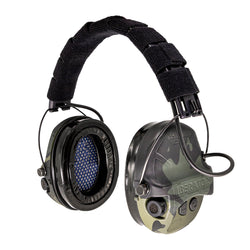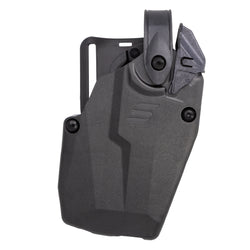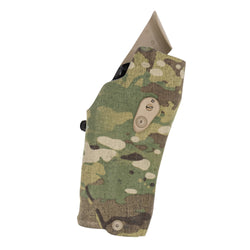Ammunition isn’t exactly cheap these days, and between busy work schedules, family obligations, and the rising cost of living, getting to the range as often as we’d like just isn’t in the cards for most of us.
But, unlike learning to ride a bicycle, shooting skills are perishable. So that once-a-year trip to the range just ain’t gonna cut it. You have to practice. And practice often. Without it, you might as well be a perpetual novice… even if you’ve been a “lifelong” shooter.
Fortunately, we live in an age awash with options. Thanks to modern arms technologies and dry fire tools like snap caps and laser trainers, it’s fairly easy to supplement range training from the comfort of your home.
Dry fire training is a highly effective, safe, and low-cost way to keep your shooting skills sharp without burning through your savings or cashing in your 401(k) to fund your ammo supply.

And while nothing replaces live fire, dry fire practice is absolutely a “second-best” option. I can’t even begin to tell you how many hours I’ve logged just running dry fire drills in my basement, especially during the winter months.
But that said, there’s more to dry fire than just running an action and pulling a trigger. It isn’t just standing in your room, aimlessly pulling the trigger for five minutes. Effective dry fire practice is deliberate. And it takes dedication and hard work.
Well, it does if you’re doing it right. Let’s discuss.
What is Dry Fire?
At its core, dry fire training is pretty simple. It is, essentially, the practice of running drills and manipulating your gun as you would in any live-fire scenario, but without any live ammo. Charge, point, pull, and click. Rinse and repeat.
Simple.
It’s a safe and affordable way to work on fundamental shooting skills, like trigger control, grip, stance, and overall technique. Think of it as building muscle memory. You’re going through all the motions you would at the range, just without the “bang.”

The best part is that dry fire can be done just about anywhere you’re comfortable. In your garage, living room, or backyard. As long as you’re being safe (ensuring that your gun’s unloaded and clearing the room of any live ammo), it’s one of the easiest and most affordable ways to improve as a shooter.
And while the term “dry fire” technically only refers to pulling the trigger and dropping the firing pin on an unloaded chamber — a practice that once stirred a bit of controversy — it’s evolved into an essential training mainstay in recent years thanks to tools like laser trainers (which we’ll get to in a bit), smart triggers, and dry fire magazines.
These tools enhance your dry fire sessions by providing live, accurate feedback, resetting triggers, or even simulating shot impacts in a way plain ole trigger pulls just can’t.
Why it Matters
For new shooters, dry fire is a great way to build confidence and get comfortable with handling a firearm. Practicing those fundamental skills in a controlled, no-pressure environment helps you develop a bit of muscle memory, get used to your gun’s operational characteristics, and establish a solid foundation.
And for newbies who might still be a little apprehensive or skittish about hitting the firing line, dry fire is a logical first step.
It’s also a perfect opportunity to work through basic drills, like drawing from a holster or reloading, at your own pace without the self-imposed stress and frustration of trying to be the next Jerry Miculek while still working out some fundamental kinks and bad habits.
And I get it. We all want to wow trainers and fellow range goers with fast shots and sub-MOA groups. But without those fundamental skills, you’re more likely to shoot like Dick Cheney. Maybe worse.
Experienced shooters rely on dry fire, too, but for different reasons. At a certain point, it becomes less about learning the fundamentals and more about refining them.
Improving. Getting better.
Dry fire training helps seasoned shooters iron out any remaining flaws in their technique, identify and eliminate bad habits, master their grip, and lower reaction times. It’s also a great way to stay sharp and maintain your muscle memory as life gets busier and range trips aren’t happening as often as you might like.
So yeah, dry fire is useful. Especially for newbies.
Is Dry fire Safe?
When done correctly, yes. But it demands strict discipline and careful attention to the cardinal rules of gun safety. This is non-negotiable.
Always triple-check that your firearm is unloaded. Remove the magazine, clear the chamber, and physically inspect it. I mean, just use your head. We’ve all heard the horror stories; there’s no sense in becoming another statistic, right?
Remove all live ammunition from your dry fire area. This kind of goes hand-in-hand with the point above. But you’d be amazed how often accidents happen when live rounds are within reach. Just do yourself a favor and completely remove the possibility of accidentally mixing any live ammo with your snap caps or mistaking a live round for your laser trainer.
Again, use your head. Even the most confident shooters make mistakes. Don’t take the risk.
Choose a designated dry fire area where there’s zero chance of unintentionally flagging a family member or causing harm to bystanders in the event of a negligent discharge. Personally, I like to use my basement, as it’s relatively open, and, well, underground. With one way in and one way out, I’m in complete control of my surroundings.
Announce aloud when you’re starting and ending your dry fire session. This helps you mentally shift gears and keeps others in the home informed, so there are no surprises. Even if you’re completely alone during your dry fire sessions, it’s a good habit to get into. Even if it seems silly, we’d all rather be safe than sorry.
And the way I see it, it’s no different than an RSO announcing a hot range or a cease-fire.
Quality Dry Fire Practice Tools
Dry fire training isn’t what it used to be. And that’s a good thing. Tools like laser trainers, auto-reset trigger systems, and digital shot-tracking devices have made dry fire safer, more realistic, and significantly more productive.
Laser Trainers
Laser trainers are likely one of the most popular dry-fire training tools. They’re cheap and readily available. And even the crappier options seem to work reasonably well.
At their core, these systems use a laser cartridge, usually with a brass shell, that fits within the chamber of your firearm. When you press the trigger and the firing pin drops on the device, it emits a brief laser pulse, simulating a shot. Paired with reactive targets or smartphone apps, these systems give instant visual feedback on your point of aim and shot placement.

Some systems, like the Mantis Laser Academy, are much more advanced. The Mantis system, for example, can track split times, shot groupings, and even detect subtle trigger press issues that might not be obvious to the naked eye.
And using Bluetooth and WiFi connectivity to deliver super in-depth shot analysis and identify areas of weakness and improvement, these systems are absolutely invaluable. Worth the investment, for sure.
Auto-Reset Trigger Systems
Although not as common or widely available, auto-reset trigger systems, such as the DryFire Mag, really take things to the next level. Instead of manually charging the weapon after every shot, these drop-in magazine systems reset your trigger automatically, letting you run rapid-fire drills and deliver more realistic follow-up shots without constantly breaking your grip to charge the weapon for another rep.
These systems seem to be a relatively new addition to the market and have plenty of room for improvement. But they’re simple yet effective, making dry fire practice feel more realistic, especially for defensive and competition shooters.

And for anyone working on rapid trigger control or target transitions, having a trigger that resets itself is a game-changer. It lets you stay in the zone, working through sequences without breaking your focus, disturbing your rhythm, messing with your “aura”… whatever. Combine that with a laser trainer, and you’re off to the races.
Granted, some of these systems can be a bit clunky, and some firearm platforms can be a bit finicky as to whether or not they’ll work with them consistently (especially as battery levels get a little low). But, more often than not, they run reliably, making dry-fire infinitely more enjoyable.
It’s worth the trade-off, in my opinion.
Mantis Laser Training Systems
All of this leads us to the Mantis family of training tools. Mantis is probably the biggest name in the dry fire product space. And for good reason. They continuously bring new training products to market that find ways to bridge the gap between live-fire and dry-fire training for a more seamless transition between the two.
Breaking barriers and blurring lines, if you will.
This is especially true with their Blackbeard and BlackbeardX product series.

With both the Blackbeard and BlackbeardX, Mantis basically took everything that was great about laser trainers and auto-reset mags and combined them to create a more holistic training system. And while it’s currently only available for the AR-15, new handgun models (and other rifle models) are currently in production.
The Blackbeard series replaces bolt carrier groups and magazines with a self-contained laser training unit. Every time you pull the trigger, it fires a laser pulse as the firing pin drops on the sensor and instantly resets the trigger simultaneously. All while also logging and transmitting accurate shot data to a paired smartphone or tablet.
I’ve run entire shoot-and-move drills in the comfort of my home, studied the results, and made minor adjustments before running the drill again without having to break my focus to constantly run the charging handle on my AR. And because it tracks every single shot, you get a running record of your performance over time. It’s a solid tool.

The only downside, though, is it’s not exactly conducive to getting you in the habit of practicing your reloads.
I guess you win some, and you lose some, right?
If you’re someone who likes measurable progress and the ability to review sessions with real data, systems like the BlackbeardX take dry fire from a mundane activity to a structured, meaningful training exercise. It’s an incredibly useful tool to have at your disposal.
Get Serious
It doesn’t matter if you’re a first-time gun owner looking to work on learning the basics or a seasoned operator with thousands of range hours under your belt, dry fire training isn’t optional. It’s a critical skill-building practice. One that is often taken for granted.
Skill and proficiency with firearms can’t be bought. You can’t shortcut training with A-tier guns and flashy gear. Instead, that proficiency is built rep by rep, and you have to put in the work. Consistently.
Even if all you can carve out of your busy schedule is a meager 10 minutes a day, it’s better than nothing. And I’m here to tell you that you’ll thank yourself later when you see real-world results at the firing line. You’ll be faster, more accurate, and more confident. Shoot, you might just be able to finally take on ol’e’ Jerry Miculek at the next IPSC competition. Okay, maybe not.
But you’ll for damn sure be a better shooter for having put in the work with a bit of dry fire training. And the best part? It won’t have cost you a dime in ammo.









